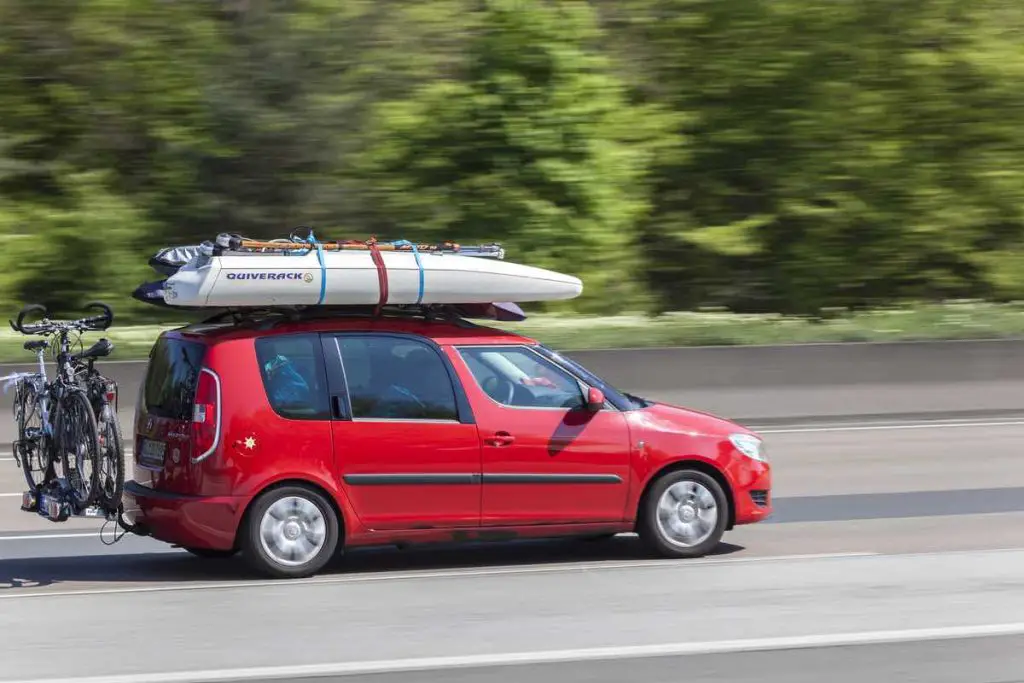Kayaking across a lake on a warm day is one of the most tranquil experiences. But that doesn’t mean you should overlook some important stuff before setting out. If you’re new to kayaking or planning to take it up on your next vacation, you might be wondering how to go about it, and there are several things you should know to arrive at your final destination safely.
It’s recommended to never exceed 60 to 80 miles per hour when transporting a kayak on your vehicle’s roof, depending on how comfortable your car feels. You should always ensure that the kayak is tied to the vehicle properly for your and other vehicles’ safety.
There are a few aspects of kayak transportation that are either ignored or not talked about enough, so here’s an overview of what to consider when you’re getting ready for your next trip.

Is It Safe To Travel With a Kayak on a Car?
Traveling with a kayak on top of a car seems like it would be the ideal combination of fun and convenience. But you’d be surprised to know that this kind of travel is a lot more complex than one might imagine, and not for the reasons you’d expect – it all starts with the question of safety.
If you’re planning to travel with your kayak on the roof of your vehicle, the right equipment is essential.
First and foremost, ensure your vehicle is suited for transporting the kayak. You’ll have straps, bow and stern tie-downs, and racks that can be used to secure it safely, as well as weatherproofing to protect it from damage due to exposure during transit.
Additionally, you want to ensure it’s properly secured so that it doesn’t go flying off the roof of your vehicle and into another lane of traffic. This can be done with bow and stern tie-downs along with other safety straps to ensure everything stays in place.
It’s important to highlight that driving your vehicle becomes pretty easy when your kayak is safely secured. If you’re using a roof rack, check the manufacturer’s recommendations regarding the maximum speed you should undertake during your journey.
As a rule of thumb, it’s safe to travel with a kayak when it is secured correctly and you do not exceed the speed of 60-80 miles per hour, depending on how comfortable your vehicle feels.
How To Transport a Kayak
If you’re lucky enough to have a kayak, the question of how to transport it is almost as important as getting it in the first place. As a newbie, if you’ve got a few kayak buddies, you can ask the more experienced personnel to take care of it with their vehicle.
But if you’re flying solo or want to kayak on your own terms, how do you get your kayak from one point to another? Knowing that you’ll need a few essential pieces of equipment to safely complete this task is vital.
Your Vehicle Should Have Crossbars
You’ve probably seen those big crossbars on the roof of a car before. Some vehicles even have factory-installed crossbars that can be used to mount roof racks.
However, there are also aftermarket crossbars that can be attached to the roof of your car, and they’re straightforward to install so long as you know where they need to be secured.
A vehicle’s metal or plastic crossbars support the roof rack. They help carry the weight from objects attached to the rack instead of letting it rest on your vehicle’s body. That is also why crossbars are usually located at the base of racks – they take up most of the load while leaving more space for other items.
J-Cradle or Saddle Kayak Racks
A J-Cradle kayak roof rack works for kayaks of all kinds, whether intended for whitewater, sea, or recreational use.
It’s an accessory that fits the crossbars of a car and is used to transport kayaks. While there are a few variations in the design of these racks, the most common is a padded metal bar cradling each side of the kayak.
The J-Cradle occupies less roof space because it carries the kayak vertically. Therefore, more space is available on the rack for equipment. They work well for transporting more than one kayak as well. Smaller boats constructed of sturdy material work well with J-Cradle kayak racks.
On the other hand, Saddle racks are excellent for carrying longer kayaks. This rack system carries the kayak horizontally and provides the best support and protection for your kayak. However, it’s only suited for transporting one kayak.
Additionally, saddle mounts work well with bigger fiberglass kayaks, SUPs, and canoes.
Bow and Stern Tie-Downs
Tie-downs are the straps that attach your kayak to your roof rack for transport. They keep the boat from flipping over or moving around too much and from falling in case of a malfunction in the mounting system.
Kayaks are long, narrow vessels with a lot of surface area and very little weight, so they can be pretty unstable when loaded onto a vehicle. At freeway speeds, bow and stern tie-downs help keep the kayak in place and prevent movement or damage.
To achieve this, bow tie-downs are placed on the front of your kayak, and stern tie-downs are placed on the back. Bow lines keep a boat from tipping over on its side, and stern lines help keep it from sliding out of place.
Wind resistance makes kayaks especially vulnerable to damage. This causes them to vibrate and flap around as they move down the road at high speeds. The bow and stern tie-downs help combat this by keeping the kayak flat against the car’s body.
Cam Straps
Cam buckle straps are another tie-down strap used to secure cargo on vehicles and other moving objects. These straps use a cam buckle mechanism to tighten the strap around the load.
This tie-down is tightened by hand and can only be as tight as the user can physically make them. There is no way for someone to over-tighten the strap.
One of the best features of cam buckle straps is that they have a quick-release mechanism. When you need to remove the strap from whatever it is securing, you must pull a tab, which releases instantly.
Using cam straps over and above bow and stern tie-downs is an extra step to ensure your kayak is secured. They are a quick and efficient way to prevent the kayak from any tie-down damage.
You’ll likely need two cam straps that are 12 ft (3.66 m) or longer to safely secure your kayak.
If you have a kayak and it’s not in use, store it in a way to avoid any damage. Are kayak racks the only solution? Read my in-depth guide to learn more about the racks and their alternatives. [Are Kayak Racks Really Necessary?]

Final Thoughts
Traveling with a kayak on top of your vehicle is very common. However, it is also a practice that can be pretty dangerous. With suitable precautions, you can ensure that you’re traveling safely.
Ensure you always stick to your kayak rack manufacturer’s specified recommendations regarding how fast you should drive.
Generally, if your kayak is correctly and safely secured, you should never exceed the speed of 60-80 miles (96.56-128.75 km) per hour, depending on how comfortable the vehicle feels.
Sources
- ETrailer: Q&A – How Fast Can I Drive With Kayaks Loaded on Roof?
- NCKayaks: Bow and Stern Lines: Care & Feeding
- PaddleAbout: How Fast Can You Drive With A Kayak On The Roof?
- RachetStrapsUSA: How to use Cam Buckle Straps Like the Pros
- ReiExpertAdvice: Transporting Your Kayak
- TruckILE: How Fast Can You Drive With A Kayak On Your Roof?
- Yakima: Types of Water Mounts
